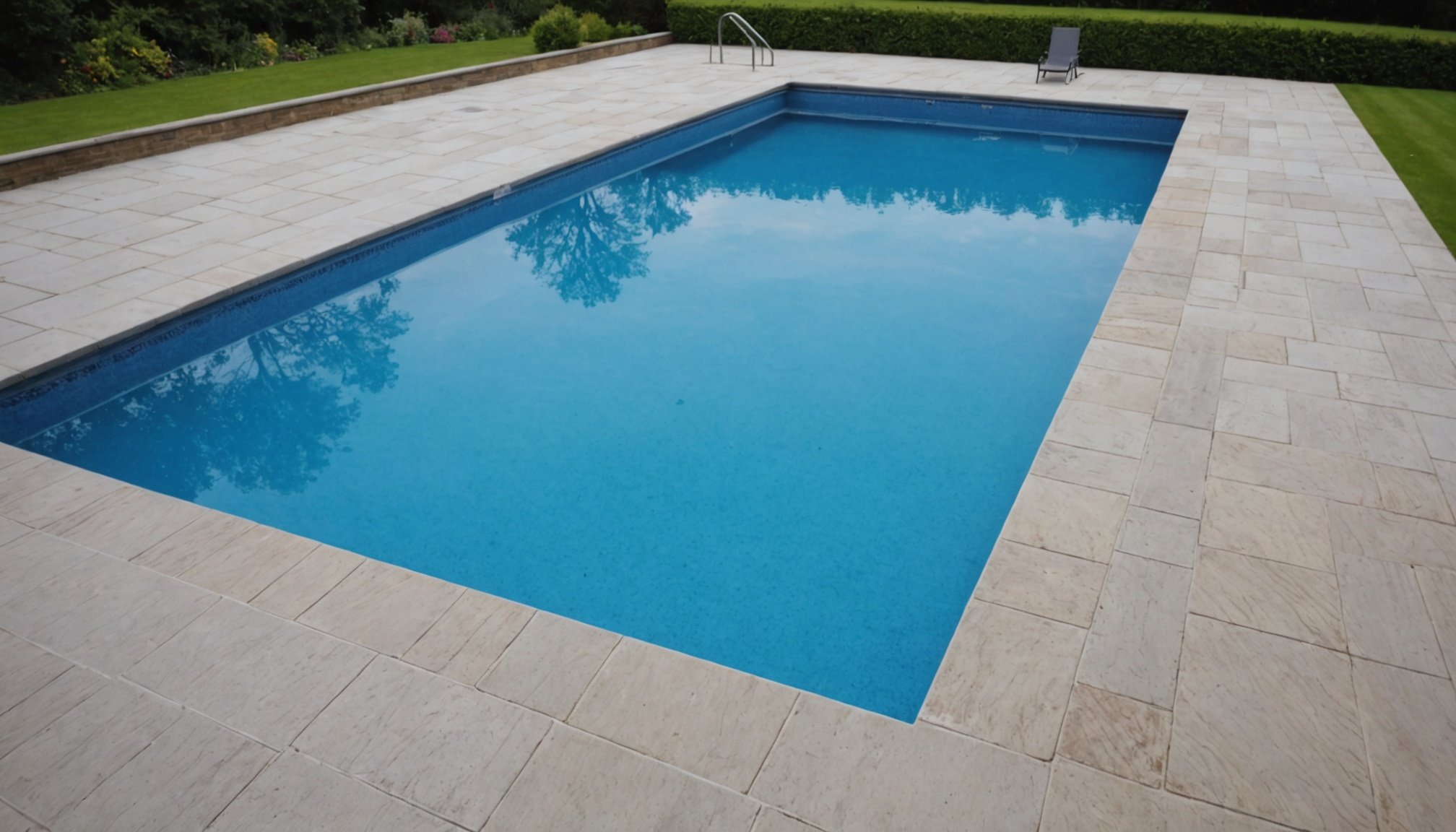Understanding the Impact of UK’s Wet Weather on Pool Coping
The wet weather effects prevalent in the UK significantly influence pool coping materials. With the frequent moisture exposure, these materials often face challenges such as cracking and the development of mold. This is primarily because excess water can infiltrate tiny fissures in the coping, expanding and contracting during temperature fluctuations, which exacerbates deterioration.
Commonly faced problems include the cracking of materials like natural stone and concrete, which are quite susceptible when left untreated. Mold is another persistent issue; it thrives in damp conditions and can cause not just cosmetic damage but also affect structural integrity over time. Given the UK’s notorious weather, moss and algae growth are also frequent, further impeding the functionality and appearance of pool coping.
Topic to read : Creating the Perfect Family Oasis: Designing a Chic and Safe Pool for Your UK Home
If moisture damage is overlooked, it can escalate to more serious concerns. Prolonged exposure without attention can weaken the entire structure of the pool area, leading to costly repairs or replacements in the future. Therefore, regular inspections and maintenance are crucial to address these wet weather implications. In turn, this proactive approach will extend the lifespan of your pool and prevent moisture-related issues from becoming severe.
Choosing the Right Materials for Longevity
In wet environments, selecting the appropriate pool coping materials is crucial for ensuring durability. Various materials, including both natural and synthetic options, offer different benefits and challenges. Let’s dive into a material comparison to see how they stack up.
Topic to read : Transforming Your UK Backyard: Year-Round Swimming Solutions for Any Climate
Natural stones such as limestone, travertine, and granite are popular for their elegance and robustness. They blend seamlessly with outdoor landscapes and provide a timeless aesthetic. However, they can be prone to etching and wear if not sealed properly, especially in high-moisture areas. Durability can sometimes be compromised without regular maintenance.
Synthetic materials like concrete and precast stone offer more controlled aesthetics and often require less upkeep. These options usually present higher moisture resistance and can be treated to mimic natural stone while being more budget-friendly. Despite their durability, they can suffer from cracking over time due to temperature fluctuations.
When comparing these options, prioritise moisture-resistant materials to reduce the likelihood of damage and increase longevity. Highly resistant natural stones benefit from sealing treatments, while synthetic alternatives can be enhanced with special coatings to bolster their resilience.
Ultimately, your choice should align with your aesthetic preferences, maintenance willingness, and environmental considerations. Balancing these factors will guide you to find the ideal solution tailored to your space, ensuring lasting beauty.
Essential Maintenance Routines
Pool maintenance is key to ensuring the longevity and safety of your pool. Implementing routine check-ups can prevent small issues from escalating into costly repairs.
Regular Cleaning Procedures
Commence by skimming the surface to remove leaves and debris daily. Regular vacuuming and brushing the walls and floors will prevent algae build-up, keeping the water crystal clear. It’s essential to check and maintain filtration systems weekly to ensure they operate efficiently.
Inspecting for Damage
During routine check-ups, pay attention to early signs of wear such as cracks, leaks, or deteriorating surfaces. Catching these early reduces repair costs and prevents water loss. Wouldn’t it be costly if problems were ignored? Inspect tiles for any shifting or missing grout, which may indicate larger structural issues.
Seasonal Maintenance Checklist
Adapting maintenance frequency according to seasonal weather changes is vital. In spring, focus on cleaning and inspecting for winter damage. Summer requires more vigilant checks due to increased pool use. As autumn approaches, clean and prepare the pool for winter before closing. Keep coping free from debris and mold by regularly cleaning it with a mild detergent, as this prevents structural integrity issues.
By following these preventative care steps, you ensure an optimal pool experience, keeping it safe and pristine throughout the year.
Protective Coatings and Sealants
Selecting the appropriate protective coatings and sealants is crucial to maintaining pool coping, especially in damp climates. These maintenance products play a significant role in preventing water damage and prolonging the lifespan of the pool structure. There is a variety of suitable sealants and coatings designed specifically for these conditions.
In environments with high moisture levels, silicone-based sealants are frequently recommended due to their water-resistant properties. Acrylic sealants can also be effective, offering a clear finish that doesn’t alter the appearance of the pool coping. Additionally, polyurethane coatings provide robust protection, known for their durability and resistance to wear.
When applying these protective solutions, it is essential to ensure maximum protection. First, thoroughly clean the coping surface to remove any debris or residues. Ensuring that the surface is completely dry before application is equally important to improve adherence and effectiveness. Always follow the manufacturer’s instructions to maximise performance.
Reapplication frequency depends on wear and environmental exposure but generally occurs every 1 to 2 years. Observing the coping condition, such as checking for signs of wear or water penetration, will help determine the best time for reapplication. Regular maintenance using these maintenance products can help preserve your pool’s aesthetic and structural integrity.
Local Regulations and Considerations
Navigating UK pool regulations requires an understanding of existing laws and guidelines impacting pool construction and maintenance. In the UK, these regulations are framed to ensure safety standards are met, protecting users and property. The importance of adhering to these regulations cannot be overstated, as non-compliance can affect insurance coverage and pose safety risks.
Key points include:
- The Building Regulations outline criteria for structural integrity and safety features like pool barriers.
- The Pool Water Treatment Advisory Group (PWTAG) provides advice on the chemical treatment and maintenance of pool water, essential for health compliance.
Ensuring compliance with these standards is crucial for both legal and practical reasons. A compliant pool not only meets insurance requirements, safeguarding owners against financial loss, but also assures the well-being of users.
To successfully navigate these regulations, working with experienced local contractors and suppliers is invaluable. They possess the required knowledge of regional regulations and often maintain established relationships with relevant authorities. Here are some tips:
- Consult with local experts early in the project to assess requirements.
- Vet suppliers for a track record of compliance and reliability.
Observing these guidelines forms the backbone of a successful and lawful pool project in the UK.
Advanced Strategies for Prolonging Pool Coping Life
Understanding longevity strategies for pool coping is essential for maintaining its integrity and appearance. Advanced techniques have emerged to combat wear and tear, particularly concerning moisture impact. Opt for materials treated with water-resistant sealants; these innovative solutions form a barrier against moisture, extending the lifespan of the coping.
Integrating expert advice on landscaping features can significantly enhance durability. Incorporating well-positioned plants and shrubs not only beautifies the pool area but also acts as a natural buffer, reducing water splash impact on the coping. Such greenery serves a dual purpose: aesthetic enhancement and functional protection, making it a savvy choice for pool owners.
Cost-effective measures are also pivotal in ensuring long-term preservation. Regular maintenance routines like re-sealing every few years and choosing high-quality, durable materials can minimise the need for costly repairs in the future. Additionally, consider installing drainage systems that effectively direct water away from the coping, further preventing moisture-related damage.
By implementing these strategies, pool owners can benefit from increased longevity and reduced maintenance costs. Embracing these expert insights not only saves money but also enhances the overall poolside experience.











